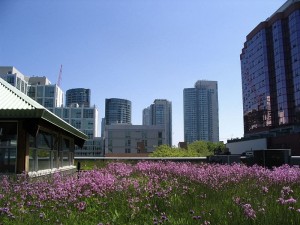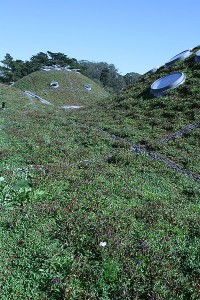 A green roof is an extension of a new or existing roof that involves a high-quality water proofing and root repellant system, a drainage system, filter cloth, a lightweight growing medium and plants. Green roof systems may be modular, with drainage layers, filter cloth, growing media and plants already prepared in movable, interlocking grids, or, each component may be installed separately. Green roof development involves the creation of contained” green space on top of a human-made structure. This green space could be below, at or above grade, but in all cases the plants are not planted in the “ground.”
A green roof is an extension of a new or existing roof that involves a high-quality water proofing and root repellant system, a drainage system, filter cloth, a lightweight growing medium and plants. Green roof systems may be modular, with drainage layers, filter cloth, growing media and plants already prepared in movable, interlocking grids, or, each component may be installed separately. Green roof development involves the creation of contained” green space on top of a human-made structure. This green space could be below, at or above grade, but in all cases the plants are not planted in the “ground.”
There is no single type of green roof that works for all buildings, climates and client needs. Green roofs can be categorized as “intensive” or “extensive,” depending on the depth of growing medium. Six inches or less growing medium depth is an extensive roof, also characterized by its lower weight, lower plant diversity, cost and maintenance. Intensive green roofs have more than six inches of growing media and tend to have higher plant diversity, higher weight, cost and maintenance.
One benefit green roofs provide is increased savings on heating and cooling energy costs. Results vary according to size of the building, climate and type of green roof, but when Environment Canada ran a simulation, they found that a typical one-story
building with a grass roof and 3.9 inches (10 cm) of growing medium would result in a 25% reduction in summer cooling needs. Field experiments by Karen Liu in Ottawa found that a 6-inch extensive green roof reduced heat gains by 95% and heat losses by 26% compared to a conventional reference roof.
Green roofs decrease the cost of meeting greenhouse gas reductions and adapting to climate change by reducing the “urban heat island effect” — the phenomenon of metropolitan areas being significantly warmer than surrounding rural areas, due to the heat-reflecting nature of concrete and other man-made materials and the release of heat from air-conditioning systems and machinery.
The reintroduction of vegetation into cities promotes natural cooling by absorbing, instead of reflecting, the sun’s rays, and through evapotranspiration. Traditional black roofs can reach temperatures of 158°F/70°C, and as a result have an enormous effect on building and ground level temperatures. One study concluded that 25% green roof coverage can reduce the urban heat island effect by up to 1.8°F/1°C. Green roofs can also mitigate air pollution levels by trapping particulates and capturing harmful gases.
Related articles
- Making green roofs even greener (vancouversun.com)
- Cheap and quick green roofs (leeddaily.com)



Awesome post! I truly believe Green roofs may be making a breakthrough in the commercial and government markets. I own a roofing company in Ohio http://www.tdc-contractors.com I’ve been hearing from several potential Clients recently who have mentioned Green roofs. We have been doing some research into what all would be necessary for install.
Excellent post. I was checking constantly this blog and I’m impressed! Very helpful information specifically the last part 🙂 I care for such info much. I was seeking this certain information for a long time. Thank you and good luck.
If there’s a single tool I could not live without in my backyard garden it’s one of those weed pullers, bought one two years ago and its been definitely useful. Scarcely any weeds in the backyard garden now!
Yes, Quite nice Blog and it have the importance in the current sense as today real estate industry and construction professionals are giving top priority to this kinds of roofing structures.I know that Intensive green roofs are prepared on deep layer of soil and on this soil flat roof gardens are planted to transform it in a green roof. Turf suits intensive green roofs and hardy plants suits visual appeal for extensive green roofs.Green Roof and A turf roof are often used in the same sense.
What a great idea! It would reduce smog the in big cites for sure. Also, it would surely be good for wildlife, like the honey bee for example. Plus you could have roof top picnics or BBQs in summer on your lunch break! lol
Regards
Ali
x
I believe that green roofs should be promoted because it is environmentally friendly.
cosplay wig